Horticulture Experts Discuss Opportunities in Soilless Culture

Engineered wood substrate components continue to generate a high level of global interest as one of the leading raw materials for the future of soilless media.
Photo by Brian E. Jackson
Milan, Italy, was the site of the 2019 International Symposium on Growing Media, Composting, and Substrate Analysis. This biennial symposium is sponsored by the International Society for Horticultural Science and is hosted at alternating locations in Europe and North America.
The world’s leading experts, including many from the U.S. and Canada, gathered at the symposium to share research findings and participate in discussions, planning sessions, and tours of growing operations and substrate manufacturing facilities. There were many hot topics at this year’s meeting, in addition to the sweltering heat wave that strangled most of mainland Europe in late June. Some of the most discussed topics of the week-long meeting are highlighted below.
Supply and Demand Both Rising
The future of growing media was on everyone’s mind as Chris Blok, Research Scientist at Wageningen University in The Netherlands, presented an overview of his recent research endeavor aimed at identifying the future demand for soilless growing media across the globe. Using several research tactics, surveys, industry data, and other metrics, Blok explained that all indicators point toward a drastic increase in the need for growing media in the next 30 years.
In these preliminary projections, it was estimated that the volume of growing media consumed as of 2017 was roughly 59 million cubic meters. By 2050, it is projected that the volume needed will exceed 240 million. There are many reasons for this drastic increase, but the two biggest may be the horticulture production advancements and surge in Asia (primarily China) and the skyrocketing trend of fruit and other traditionally soil-grown food crops being produced in containers that need soilless growing media.
Projections on the increased volume demand for individual growing media components was also interesting, with wood fiber leading the way with a projected 1250% increase in demand and use by 2050. The world’s peat supplies are expected to remain critically important, with an estimated 80 million cubic meter volume demand, double what it was in 2017. Of course, many variables can shift these estimates, and only time will tell which component and to what extent it/they will be used in the future. For now, the anticipation is high for a prosperous future for the growing media industries.
Wood and Food Were Hot Topics
Wood substrates were one of the most discussed topics during the education sessions at the Symposium. By my count, the word wood was spoken in some context more than any other material after the first two days of sessions. Making its way into more experimental projects as a treatment, wood materials from four continents were discussed in some capacity. While most wood materials are still being utilized as a component in peat (40% or less most often), some are pushing the boundaries higher.
Food production in soilless culture systems, and the growing media needed in those systems, was of course front and center among scientists and industry professionals from across the globe. With soft fruit and leafy greens/herbs leading the way, the excitement surrounding the need of growing media in edible plant production was contagious.

Increased production of vegetables, herbs, and leafy greens will continue to rely on soilless substrates as the production acreage continues to increase across the globe.
Photo by Paula van Ommen
Containerized fruit producers, primarily blueberries and strawberries, in South America and Mexico seem to be trailblazing the future of fruit production in soilless systems. However, growers in many other locations are transitioning or expanding their operations into container production as well. Citrus may be the next big new market, as exciting potential for container production continues to increase in that industry.
The Potential of Cannabis
The interest in cannabis, which some say is either the gateway crop of the future or a trending bubble poised to burst, cannot be denied. With the number of countries (or states) legalizing this crop, its future is bright across many facets of horticulture. The void in scientific data and reliable crop production information is still great, but at least now there are many public and private organizations beginning (or furthering) efforts to better understand this crop. Researchers, myself included, have started collaborating and strategizing on how to advance this emerging industry.

Cannabis production in soilless substrates continues to intrigue, energize, and motivate new ventures and excitement in the growing media industry.
Photo by Brian E. Jackson
Other than these chosen topics, many others were discussed, including the need (demand) for lower greenhouse gas emissions, methods for measuring greenhouse gas emissions, continued interest in adding biology to growing media, water-use efficiency, cradle-to-grave certifications, life-cycle assessments on growing media components, reuse and recycling of growing media, compost management and utilization, and many others. The next Growing Media Symposium will be held in Belgium in June 2021.









